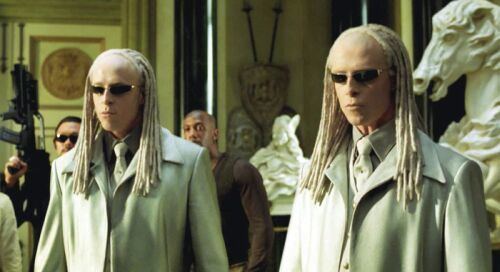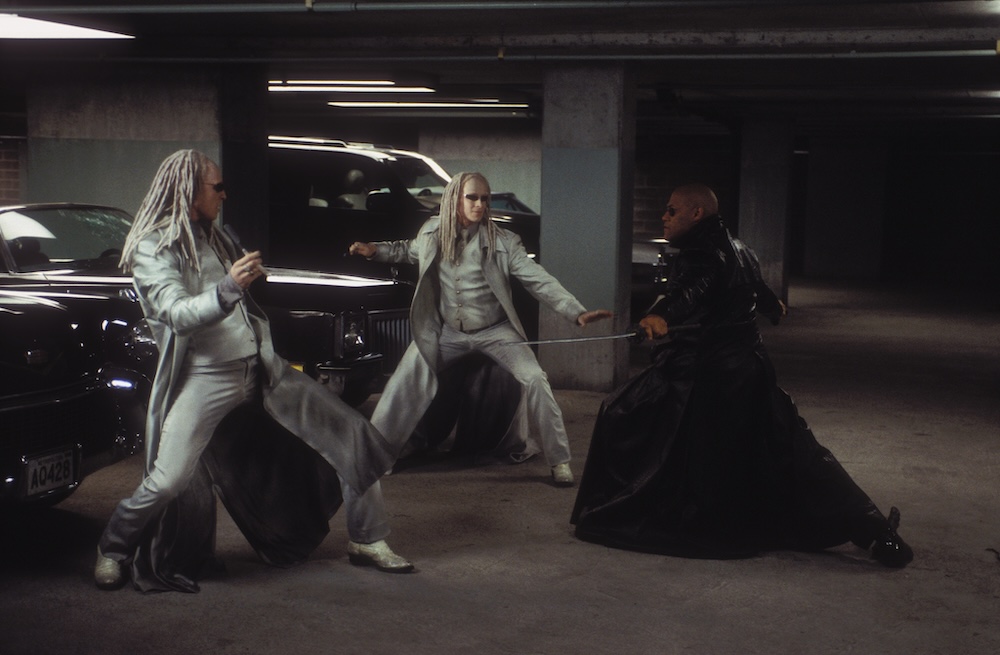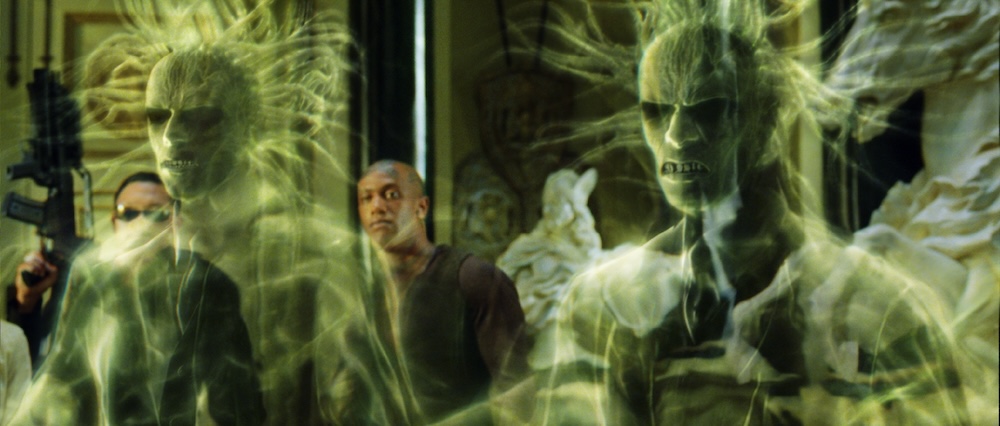The Matrix Reloaded has two bad guys that are unlike any other in the trilogy. Neil and Adrian Rayment play the Twins, who are not human soldiers, AI intelligences made to serve and protect, or even regular programs with clear roles in the Matrix's hierarchy. They are something stranger and more unsettling: deleted programs, bits of old code that shouldn't be there but are still there in ghost form, working under rules that don't really apply to them.
The films use the Twins to talk about questions like what it means to be obsolete, what it means to exist in a digital world, and what it means to be something that is no longer intended. The Twins are one of the most philosophically rich ideas in the Matrix trilogy. In the movies' world, they are ghosts in the most literal sense. They are code that was supposed to be deleted but somehow stayed around. They move through the Matrix in a ghostly way, and their white clothes and pale skin set them apart from the dark world outside and the flat surfaces of the Matrix.

They come and go with an unsettling grace, and their presence is more like a ghost than a chase. The Twins are truly disturbing not just because of how they look, but also because of what that look means. They embody a mode of existence that transcends the Matrix's designated classifications. They shouldn't be. Their presence is strange; it's a glitch that won't go away even though it's been marked for deletion. In a universe run by the Architect's careful design, the Twins are a broken thing, something that got away from the system's attempts to fix itself, and something that lives outside of the normal rules of existence.
Programs That Go Beyond Their Purpose
The Matrix trilogy sets up a hierarchy of existence in its digital world. The Architect, who made the whole system, is at the top. Below that are programs like the Oracle, Agent Smith, and different sentinels, each with a clear job and purpose. In some ways, these are conscious beings, but their consciousness serves a purpose. What they do is who they are. Their identity and their role are one and the same.
The Twins stand for something completely different. They are programs that don't have a clear purpose, and consciousness that doesn't have a clear function. They have been marked for deletion, which means they will be taken out of the system. But they keep going. This persistence is not like the Keymaker's rebellion against his job. The Twins are not choosing to fight against being erased. Instead, they are the result of an incomplete deletion, which means that the purging process didn't completely remove them from the system.
This brings up a deep question about what it means to exist digitally. Is it possible for something that has been marked for deletion, that should not exist, that has been separated from its intended function, to still exist in a meaningful way? The Twins seem to live in a place that is neither real nor not real. They are real enough to go after Neo and his friends and threaten them. They can move, do things, and kill. But they also have a ghostly, ethereal quality that makes them seem like they aren't really there in the same way that other beings in the Matrix are.

To understand what they are, you need to know how white they look. The Twins are painted in pale shades that are almost see-through, while other programs and people usually wear black or dark colors. Their looks suggest something that is fading, something that is becoming less real, something that exists on the line between being there and not being there. Their albinism, which makes them look different, is a visual metaphor for their basic status as anomalies, or beings whose very existence is strange and exceptional.
Digital Afterlife and Obsolescence
One of the most interesting things about the Twins is what they say about the digital afterlife. In the Matrix universe, deleting a program doesn't mean that it no longer exists. They can still work within the system, but they have been moved to secondary networks or put in the older parts of the Matrix's architecture. Deleting something doesn't mean getting rid of it completely. It means being sent away, moved, or taken away from your main duties. In this way, the Twins seem to be programs that have been deleted, pushed to the edges of the system, and forced to live in the code's dark areas.
This makes me think of a digital purgatory. It's not clear that the Twins are bad. They are not meant to be destroyers or corruptors. They are just old. Their original roles, whatever they were, don't work for the system anymore. The Matrix didn't just get rid of them; it put them in a kind of permanent exile. They still exist, are still aware, and are still conscious, but in a weaker state, outside of the normal structures that organize digital life.
In Reloaded, Morpheus and Neo chase each other through dark, winding passages where the Twins are very good at what they do. These are the Matrix's forgotten areas, the ones that aren't being actively maintained anymore, and the secondary and tertiary layers where old code still works. The Twins move through these spaces with a sense of ease and comfort that makes it seem like they belong there, unlike living programs. They have adjusted to being exiled and made it their home.
The Beauty of the Ghostly
One of the most thought-out parts of the Twins' character design is how they look. They move with a fluid grace that makes it seem like they aren't subject to the same physical laws as other things in the Matrix. At the edges of perception, they seem to come and go. As they move, they leave behind trails of white light. It's creepy how in sync their movements are, as if they have one mind that is split between two bodies.

This choice of style says a lot of things at once. First, it makes them stand out from the other bad guys in the trilogy. Agent Smith is dangerous and powerful, but he still seems to be based in the real world. The Agents are effective, but they are real. The Twins, on the other hand, seem to be a little bit separate from reality, as if they aren't as solid as other beings. They are more like ghosts or visions than real people.
Second, the ghostly look suggests that something is very fragile. The Twins are good fighters and dangerous foes, but there is something sad about their lives. They are holding on to a way of life that isn't natural for them. They should be gone, but they keep coming back. In some ways, this persistence is admirable, but in other ways, it's sad. They exist because the system hasn't completely destroyed them, not because they've successfully claimed a place in the intended order.
Third, the way the Twins look makes it feel like time is changing. They seem to be moving a little out of sync with the rest of the world, as if they are experiencing time differently than other beings. This idea that deleted programs see the world in a very different way makes us think about what consciousness and time mean in the digital world. The Twins are not just copies of normal programs if they experience time differently or see reality through a different lens than other programs. They are something changed, something that has become completely foreign because they were deleted and exiled.
Fragmentation and Two Minds at Once
The fact that there are two Twins who are always together and always moving in sync makes me wonder about the nature of their consciousness. Are they two different beings who have decided to stay together, or are they pieces of one consciousness that have split into two forms? The movies point to something more like the latter. The Twins appear to have an understanding that goes beyond just talking to each other. They think, act, and move as one.
This implies that their deletion might have entailed a fragmentation of their original consciousness. Maybe they were one program that got split up or divided when someone tried to delete it. Or maybe they have combined their separate minds into a single, shared mind. In any case, their existence as twins, their constant pairing, and their synchronized movement all point to a consciousness that is spread out across two bodies in a strange way.
This distributed consciousness prompts philosophical inquiries regarding the essence of identity and individuality. If the Twins are parts of one consciousness, are they one being or two? If they are two distinct entities that have opted to amalgamate their consciousnesses, what implications does this amalgamation hold for their individual identities? The movies don't directly answer these questions, but the way the Twins look, how they dance, and how they move all suggest that these are questions worth asking.
The Agency of the Deleted
The most philosophically unsettling aspect of the Twins is their embodiment of the potential for agency to arise from erased code. They don't have a clear job to do. But they do things on purpose. They chase, they hunt, and they seem to have a purpose beyond just deleting. Where did this agency come from?
One possibility is that the Twins are aware of their own deletion and are working to stop it in order to show that they are still important in the system, even though they are marked for removal. They might be trying to prove that they still exist by going after Neo and the other freed humans. This would be a way of going against the system that has tried to erase them.
Another option is that they are doing what the Architect wants them to do and that their apparent deletion is just a cover for a different job. Maybe they were marked as deleted but were actually kept as black ops, which is the system's most desperate tool against threats that regular programs can't handle. In this interpretation, the Twins' ghostly quality would not be due to unsuccessful deletion but rather an intentional characteristic aimed at enhancing their concealment and tracking difficulty.
Another possibility is that the Twins really do have their own agency. They have escaped not only deletion but also control. They are not rebels against the system or servants of it. They are just orphaned minds, or minds that have been cut off from the things that usually hold digital life together. They do not act out of obedience to commands or rebellion against them; rather, autonomous consciousness, when liberated from programmed objectives, inherently produces its own motivations and will.
Unclear Hostility
The Twins are really philosophically interesting because they are fundamentally ambiguous as enemies. It's clear that they are against Neo and the resistance. They are after them with deadly intent. They are obstacles that must be overcome. But there is nothing inherently bad about them. They aren't going after Neo because they hate him or because they work for a system that hates him. They are going after him because that's what deleted programs do, because that's how they stay alive, and because doing something, anything, is better than being completely erased.
This lack of clarity makes it harder to make quick moral decisions. The viewer gets the idea that the Twins aren't really bad, even though Neo has to fight them and win. Even though they are dangerous, they are also sad. They are victims of the system, even though they threaten its enemies. They exist in a moral gray area where it's hard to tell if they are villains, victims, or something else that doesn't fit into either of those categories.
Echoes of Being Outdated
In a larger sense, the Twins show how the trilogy is interested in things that are no longer useful and how time goes by. The Matrix Reloaded is about how time goes in circles in the Matrix. Each time the Matrix runs, it makes a "chosen one" who wakes up, fights the system, and loses. The cycle then starts over again. Because time is cyclical, every version of reality will eventually become useless and be replaced by a new one.
The freed people, the rebellion, Morpheus and his crew, in a way, are all out of date. They are things that came from earlier versions of the Matrix and are no longer meant to exist in the current one. They stay alive because they have gotten away from the system's control, not because they are meant to be a part of the current paradigm. In this way, they are like the Twins. Like the Twins, they are ghosts of an old order that is no longer in use.
So, the Twins are like a mirror for the human resistance. They show what it looks like when you are no longer useful, when you have been marked for deletion, and when you keep going outside of the system's intended design. The Twins are a more extreme version of what humans are going through, but they show the same basic ontological problem. What does it mean to be alive when you weren't meant to be? What do you do, how do you move, and how do you stay alive when the system says you should be removed?
What Deletion Is
What the Twins say about deletion in the digital world is probably the most disturbing thing about them. It doesn't look like deletion is clean or final. Deleted programs stay around, but in a different form, in the margins, in the forgotten spaces, and in the system's secondary architectures. They are diminished, they are weakened, they are forced into exile, but they are not erased.
This makes it seem like real deletion might not be possible. It may be impossible to completely destroy consciousness once it has been created. It can be hidden, broken up, or pushed to the edges, but it can't be completely erased. The Twins are an example of this. They show that even deletion isn't permanent; once something exists, it has a kind of persistence that makes it hard to get rid of completely.
This has effects that go beyond the digital world and into the realm of consciousness and existence in general. If deletion is not definitive, and consciousness endures despite attempts to suppress or annihilate it, then consciousness may be more fundamental than the structures that seek to contain or regulate it. The Twins say that existence itself is tougher and more flexible than any system made to organize or control it.
Apparitions within the Mechanism
The Twins are still one of the most interesting characters in The Matrix trilogy because they are so hard to put into a box. They are not bad guys, but they are against the good guys. They work for the system, but they aren't really loyal to it. They are alive, but not in a way that fits the usual definitions of life. They are aware, but not in a way that clearly relates to purpose or meaning.
The Twins ultimately symbolize the enigma inherent in consciousness and existence. They propose that consciousness and agency can endure even in circumstances that appear to render them unattainable. They say that the lines between existing and not existing, being and not being, are not as clear-cut and safe as rational systems would have us think.
The Twins are programs that have been deleted but won't go away completely. They are ghosts in the machine, spectral remnants of old code that somehow still work and matter. The fact that they are in the movies makes people face uncomfortable truths about what it means to live in a digital world and, by extension, about consciousness itself. They propose that deletion is never total, that exile is never definitive, and that once consciousness arises, some form of existence and agency will persist, regardless of the system's intentions.
When people watch the Twins move through The Matrix Reloaded, they see a truly tragic figure. They are beings that shouldn't exist, that have been marked for death, and that only exist in a smaller form in the code's forgotten areas. But they keep acting, moving, threatening, and chasing. Their refusal to accept final deletion is not a victory, but it is also not a loss. It is simply the persistence of consciousness in conditions that seem designed to deny it any right to persist. And in that persistence, the Twins represent something deep about how awareness itself is stubbornly strong.